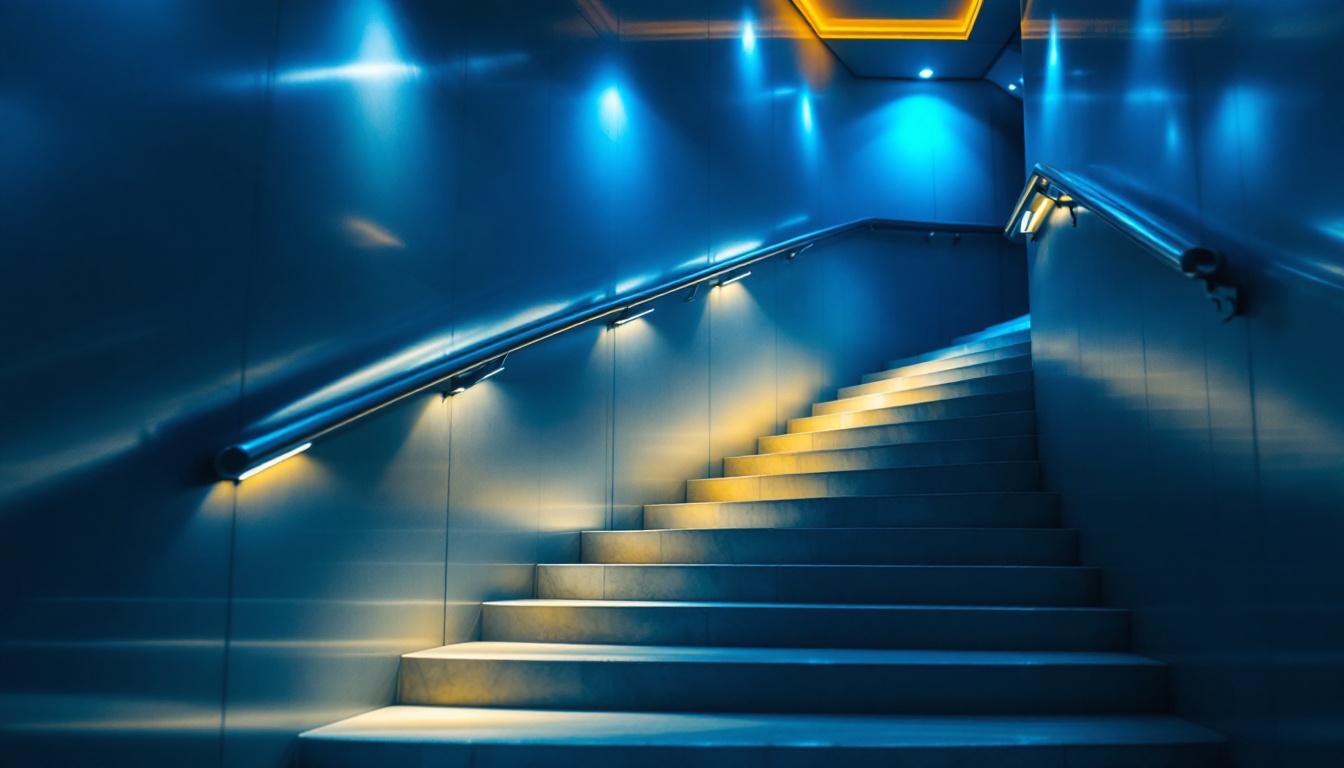
Stairways are often overlooked when it comes to lighting design, yet they play a crucial role in safety and aesthetics within a building. Proper lighting in stairwells not only enhances visibility but also contributes to the overall ambiance of a space. For lighting contractors, understanding how to optimize stairway ceiling lights for maximum efficiency is essential. This article delves into the best practices and considerations for achieving effective lighting solutions in stairways.
Stairway lighting serves multiple purposes. Primarily, it ensures safety by illuminating steps and landings, reducing the risk of accidents. However, it also contributes to the overall design of a space, guiding the eye and enhancing architectural features. A well-lit stairway can transform a mundane passage into an inviting focal point. The choice of lighting fixtures can also reflect the style of the home or building, whether it be modern, traditional, or eclectic, further integrating the stairway into the overall aesthetic of the environment.
Safety is paramount in stairway lighting. Poorly lit stairways can lead to accidents, particularly in commercial buildings where foot traffic is high. Ensuring that every step is adequately illuminated helps prevent slips and falls. Additionally, lighting should be consistent and free of dark spots, which can be disorienting for users. Incorporating motion sensors can also enhance safety by automatically activating lights when someone approaches, ensuring that the stairway is always well-lit when needed. Furthermore, using non-glare fixtures can help maintain visibility without causing discomfort to the eyes, creating a safer and more pleasant experience for all users.
Beyond safety, stairway lighting can enhance the aesthetic appeal of a space. Creative lighting designs can highlight architectural elements, such as railings or wall textures, adding depth and character. By utilizing various lighting techniques, contractors can create a visually striking environment that complements the overall design theme. For instance, recessed lighting can provide a sleek and modern look, while wall sconces can add a touch of elegance and warmth. Moreover, the use of colored LED lights can create dramatic effects, allowing homeowners to change the mood of the space according to different occasions or personal preferences. This versatility not only enriches the visual experience but also allows for a unique expression of style that can be tailored to individual tastes.
Choosing the right type of ceiling light for stairways is crucial for achieving the desired effect. Various lighting options are available, each with its unique advantages and applications.
Recessed lights are a popular choice for stairways due to their sleek appearance and ability to provide even illumination. Installed into the ceiling, they create a clean look that does not intrude on the stairway’s design. When strategically placed, recessed lights can effectively illuminate each step while minimizing shadows. Additionally, they can be outfitted with dimmer switches, allowing for customizable brightness levels depending on the time of day or occasion. This adaptability makes recessed lighting not only functional but also versatile, enhancing the overall ambiance of the stairway.
Pendant lights offer a more decorative option for stairway lighting. Hanging from the ceiling, they can serve as statement pieces while providing ample light. When using pendant lights, it is essential to consider the height of the ceiling and the spacing between fixtures to ensure even illumination throughout the stairway. Furthermore, pendant lights come in a variety of styles, from modern to vintage, allowing homeowners to express their personal taste. Selecting fixtures with adjustable heights can also help in achieving the perfect balance between style and functionality, ensuring that the light is cast where it is needed most without obstructing views or pathways.
Wall sconces are another excellent option for stairway lighting. These fixtures can be mounted on the walls alongside the stairs, providing additional light without taking up ceiling space. Wall sconces can be used in combination with ceiling lights to create a layered lighting effect, enhancing both safety and aesthetics. Moreover, they come in various designs and finishes, making it easy to find options that complement the overall decor of the home. Some wall sconces even feature motion sensors, which can be particularly useful in stairways, automatically illuminating the area when someone approaches, thus adding an extra layer of safety during nighttime use.
To achieve maximum efficiency in stairway lighting, several factors must be considered, including the type of bulbs used, the placement of fixtures, and the overall design of the lighting scheme.
The choice of bulbs significantly impacts the efficiency and effectiveness of stairway lighting. LED bulbs are highly recommended due to their energy efficiency and long lifespan. Unlike traditional incandescent bulbs, LEDs produce less heat and consume less energy, making them a cost-effective option in the long run.
Proper placement and spacing of lighting fixtures are critical for achieving uniform illumination. As a general rule, fixtures should be spaced evenly along the stairway to avoid dark spots. The height at which lights are mounted also affects their performance; fixtures should be positioned to minimize glare while maximizing visibility.
Incorporating dimmers and motion sensors can further enhance the efficiency of stairway lighting. Dimmers allow for adjustable brightness levels, enabling users to customize the lighting according to their needs. Motion sensors can automatically turn lights on and off based on occupancy, ensuring that lights are only used when necessary, thus conserving energy.
Designing an effective stairway lighting scheme requires a thoughtful approach. Several key considerations can help ensure that the lighting not only meets functional needs but also aligns with the overall design aesthetic.
The style of the lighting fixtures should complement the overall theme of the building. For modern spaces, sleek and minimalist fixtures may be appropriate, while more traditional designs may call for ornate chandeliers or sconces. Matching the lighting style to the architectural elements of the stairway can create a cohesive look.
Color temperature plays a significant role in the ambiance of stairway lighting. Warmer tones (2700K-3000K) create a cozy and inviting atmosphere, while cooler tones (4000K-5000K) provide a more energetic and alert environment. The choice of color temperature should align with the intended use of the space and the overall design vision.
Layering different types of lighting can enhance both functionality and aesthetics. Combining ambient, task, and accent lighting creates a well-rounded lighting design that caters to various needs. For instance, using recessed lights for general illumination, wall sconces for accent lighting, and pendant fixtures for decorative elements can create a dynamic and visually appealing stairway.
In today’s environmentally conscious world, energy efficiency and sustainability are more important than ever. Lighting contractors should consider eco-friendly practices when designing stairway lighting solutions.
Opting for energy-efficient fixtures is a fundamental step toward sustainability. In addition to LED bulbs, contractors should look for fixtures that have energy-saving features, such as integrated sensors and dimming capabilities. These features not only reduce energy consumption but also contribute to lower utility bills for building owners.
Smart lighting technology offers innovative solutions for energy efficiency. By integrating smart systems, contractors can provide clients with the ability to control lighting remotely, set schedules, and monitor energy usage. This level of control not only enhances convenience but also promotes responsible energy consumption.
Finally, proper recycling and disposal of old lighting fixtures and bulbs should be a priority. Many communities offer recycling programs for incandescent and fluorescent bulbs, while LEDs can often be disposed of through electronic waste programs. Educating clients about these options can help promote sustainable practices in lighting design.
Examining successful stairway lighting projects can provide valuable insights and inspiration for contractors. These case studies highlight innovative approaches and effective solutions that have enhanced both safety and aesthetics.
In a recent commercial office building project, recessed LED lights were installed throughout the stairway. The design incorporated motion sensors that activated the lights when someone approached the stairs, ensuring safety without wasting energy. Additionally, the use of a warm color temperature created a welcoming atmosphere that aligned with the building’s modern aesthetic.
A residential home renovation project featured the installation of pendant lights in a spacious stairwell. The fixtures were chosen to complement the home’s traditional design while providing adequate illumination. The contractor also incorporated wall sconces to create a layered lighting effect, enhancing both safety and visual interest.
In a public library, the stairway lighting design focused on creating an inviting environment for visitors. A combination of recessed lighting and decorative fixtures was used to highlight architectural features while ensuring safety. The project also included energy-efficient LED bulbs and smart lighting controls, promoting sustainability and reducing energy costs.
Optimizing stairway ceiling lights for maximum efficiency involves a combination of thoughtful design, appropriate fixture selection, and energy-saving practices. By understanding the importance of stairway lighting, choosing the right types of fixtures, and implementing strategies for efficiency, lighting contractors can create safe, aesthetically pleasing, and sustainable lighting solutions. As the demand for innovative lighting designs continues to grow, staying informed about the latest trends and technologies will be essential for success in the industry.
Ready to elevate your stairway lighting projects with the best in efficiency and design? Look no further than LumenWholesale, where we provide lighting contractors with exceptional, spec-grade lighting products at unbeatable wholesale prices. Say goodbye to inflated markups and hello to a vast selection of industry-standard, high-performance lighting solutions. With free shipping on bulk orders, LumenWholesale is your go-to source for premium lighting without the hidden fees. Don’t compromise on quality or value — explore our collection and discover the ideal lighting for your next project at the best value.

Discover essential tips and common pitfalls for lighting contractors working with LED ballasts.

Discover how investing in LED light bulbs can transform your lighting contracting business.

Discover the essential checklist for lighting contractors to ensure flawless can lighting installations.

Explore the evolution of lighting technology as we delve into the innovations that succeeded Edison’s incandescent bulb.